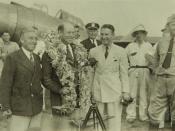Shanks and St. John (1994) claimed that the proposal of dissociable human learning systems - explicit and implicit learning systems is based on the following - explicit learning takes place with concurrent awareness and involves encoding of instances or fragments; implicit learning takes place without concurrent awareness and involves unconscious rule learning. In their review article, they concluded that generally implicit learning was unsupported with consideration to instrumental learning tasks, Pavlovian and evaluative conditioning models, sequential reaction time tasks and so on. This review would concentrate on the domains of Serial Reaction Time tasks, Pavlovian and evaluative conditioning models, with close reference to whether relevant empirical evidence would support the view of implicit learning or not. A domain which Shanks and St. John (1994) had ignored - people with dyslexia, would also be discussed.
As implicit learning is classified as unaware, Shanks and St. John (1994) proposed two criteria tests of awareness for implicit learning should meet.
The first one was the 'information criterion' - before concluding that subjects are unaware of the learned information that influences their behavior, the experimenter must be able to establish that the information he or she is looking for in the awareness test is indeed the information responsible for changes in performance. They also devised a second criterion - the sensitivity criterion, which stated that unaware learning must achieve an adequate level of sensitivity. In detail, in order to show that two dependent variables say tests of conscious knowledge and task performance relate to dissociable underlying systems, we must be able to show that our test of awareness is sensitive to all of the relevant conscious knowledge. Unless this criterion is met, the fact that subjects are able to transmit more information in their task performance than in a test of awareness may simply because performance test is more sensitive to whatever conscious information the subject has encoded (Shanks & St. John, 1994). It was based on the two criteria that Shanks and St. John (1994) concluded that there was no reliable evidence available to support implicit learning. In the research field, it was also based on their two criteria where researchers had become more cautious in making conclusions about supporting implicit learning, and they had also become more motivated to address the definitional operations of awareness.
Regarding Pavlovian conditioning paradigm, a well-established paradigm in learning, Shanks and St. John (1994) argued that the dissociation between learning of reinforcement contingence and presence of awareness was yet to be formally established. They outlined an experiment by Lovibond (1992) to illustrate the approach of eliciting measures of concurrent awareness with conditioned responses. Firstly, during the learning phase subjects adjusted a pointer continuously to indicate their moment-by-moment expectation of shock. Secondly, when the experiment ended, a structured interview was administered to assess the awareness of participants.
In each of the experiments in Lovibond (1992), some subjects could not indicate on both awareness tests that they associated A with shock to a greater extent than B. Critically, these subjects could not demonstrate stronger conditioned responding to A than to B. On the contrary, galvanic skin responses (GSR) were stronger to A than to B for subjects who were aware of the conditioning contingencies (Lovibond, 1992). Thus on these results Shanks and St. John (1994) concluded that learning about a conditioned stimulus (CS) paired with shock relationship did not occur when awareness of that relationship was absent. Shanks & St. John (1994) also quoted similar studies that disregarded implicit learning in the Pavlovian conditioning paradigm (Boakes, 1989; Dawson & Schell, 1985).
However, there are three studies that produced neurological evidence on Pavlovian conditioning paradigm that suggested the possibility of learning without conscious awareness, disputing the claim by Shanks & St. John (1994) that concurrent awareness was a prerequisite for Pavlovian Conditioning (Esteves et al, 1994; Wong et al., 1997; OE hman and Soares, 1998). They all had revealed that both skin conductance response (SCR) and event-related brain potentials (ERPs) could be conditioned without being consciously aware of the contingent relationship between the conditioned stimulus (CS) and the unconditioned stimulus (US). Esteves et al. (1994) paired subliminal presentations of angry (experiment 1) and happy (experiment 2) human faces with aversive shock. During a subsequent supraliminal extinction phase, angry faces elicited greater SCR responses than stimuli that was not conditioned, suggesting that autonomic responses can be learned in an unaware fashion in response to fear-relevant stimuli, in this case an angry face. This effect did not occur, however, when the happy faces served as the CS. Secondly, OE hman and Soares (1998) replicated these results using snakes and spiders as fear-relevant stimuli and flowers and mushrooms as fear-irrelevant stimuli. In addition, Wong et al. (1997) utilized an aversive shock conditioning paradigm to demonstrate that brian waves can be conditioned to stimuli that could be accessed through perception. Wong et al. (1997) paired an unpleasant face with an aversive shock during a subliminal conditioning series. Results of their study found that N1, P2 and P3 ERP components reliably differentiated the CS+ (unpleasant face) from the CS (pleasant face) during a supraliminal postconditioning phase. In combination, these studies suggested that both ERP components and SCR can reliably differentiate between control stimuli and conditioned stimuli that were acquired without subjects being consciously aware of the contingent relationship CS+US and CS-US contingenies. In a later study, Bunce et al. (1999) confirmed that the unpleasant face elicited greater electroencemagnetograph (EMG) amplitude in the postconditioning phase than in the preconditioning phase, whereas EMG amplitude decreased from pre- to postconditioning for the pleasant face. Poststudy questionnaires administered revealed no differential reactions to the stimuli in the postconditioning phase in comparison to the preconditioning phase. Only one of the eight subjects in their study thought that the shock might have been paired with the unpleasant face. These self-report data lent even more support to arguing that the stimuli were subliminal, and that the subjects were not aware of a contingency between the CS+ and the US. Neither were they perceptually able to distinguish between the stimuli during the forced-choice recognition task, nor they were capable of guessing correctly the contingency between the CS+ and the US.
In fact, accurately measuring unconscious learning processes had been difficult. It could be explained by the process-purity problem (Curran, 2001). When we learn, an inter-play of explicit and implicit knowledge would usually be involved, making process-pure assessment tasks for implicit learning difficult to conduct. The 'method of opposition' suggested by Jacoby and colleagues (1991, 1998) reasoned that conscious and unconscious processes might be separated if they were placed in opposition such that they would influence performance in opposite ways. This method was supported by Shanks and St. John (1994) as an empirical methodology to test for implicit learning. The method of opposition assumed that there are variations in intentional control between conscious and unconscious processes. People can manage the way to use information when it can be accessed consciously, for instance responding 'non-famous' to names that are recollected from a study list. However, as people lack control over using unconscious information, a person's behaviour may conflict with his or her true intentions, say responding 'famous' to a name that is merely familiar because it was on the study list.
Turning to Serial Reaction Time tasks, there was recent compelling evidence by Destrebecqz and Cleeremans (2001) that supported implicit sequence learning without awareness by using the method of opposition. They applied the method of opposition in a Serial Reaction Time (SRT) experiment. There were two conditions in their SRT task which placed implicit and explicit knowledge in opposition. In the 'inclusion' condition, participants were asked to press response keys in an order following the sequence in the SRT task. On the contrary, participants were asked to press response keys in an order that mismatched the sequence in the 'exclusion' condition. It was expected that participants having good explicit knowledge of the material would regularly follow the sequence in the inclusion condition but not under the exclusion condition. However, people having no explicit knowledge about the material tend to generate the sequence equally often on inclusion and exclusion trials.
In their experiment, two groups - the 'RSI' and 'non-RSI' groups of participants were tested in conditions that led to different levels of explicit knowledge. The 'RSI' group, was given a brief pause between each response and the appearance of the next stimulus while the non-RSI group was not given any pauses. The RSI group showed a large difference between sequence and random SRT trials as well as generating the sequence significantly more often for inclusion than exclusion trials. Thus, the RSI group learned the sequence, but that learning was at least partially attributable toexplicit knowledge. The non-RSI group also performed more quickly in sequence compared with random SRT trials, but their generation performance suggested an implicit learning system was operating. The non-RSI group generated the sequences in the inclusion as often as in the exclusion condition. Moreover, participants' ability to discriminate between parts of the sequence in a final recognition test was consistent with their generation performance. Therefore, Destrebecqz and Cleeremans (2001) had indeed produced a compelling procedure that could satisfy both the Sensitivity criterion compared with commonly used tests for awareness in experiments in this domain - the 'exclusion' condition could apparently tap more deeply into the conscious knowledge pool of participants compared with just administering the 'inclusion' condition, which was what most previous common tests had done. Concerning the Information criterion, it is also with little doubt that knowledge learnt by participants concords highly with that used in the awareness tests.
One domain that Shanks and St. John (1994) did not really consider is dyslexics. In a study carried out by Roodenrys and Dunn (2007) which aimed to investigate the implicit learning ability of dyslexics, they used a different task that does meet the information and sensitivity criteria. Their task involved presenting a continuous sequence of stimuli that included a target stimulus to which the participant must respond by pressing a button as quickly as possible. Participants were not informed that another stimulus reliably appears before the target and so can act as a cue to the presentation of the target and facilitate response time. Results revealed that dyslexic children responded more slowly than the control group in overall, but showed the same degree of implicit learning as normal readers, thus, providing evidence for an unimpaired implicit learning mechanism in dyslexic individuals (Roodenrys & Dunn, 2007). Their results held profound implications for the underlying mechanisms of learning.
To sum up, the claim by Shanks and St. John (1994) that there is no reliable evidence of implicit learning is questionable when we consider the evidence supportive of implicit learning in this review. It might due to the fact that there were inadequate experimental methods that could readily meet the Sensitivity and Information criteria at their time. To shed light on the issue, more sensitive tests should be designed and thus be conducted. There were also some domains of human learning where Shanks and St. John (1994) did not consider in depth - human motor learning, contextual cuing (Olson & Chun, 2001) and learning in children with developmental dyslexia (Roodenrys & Dunn, 2007). By considering human learning in a broader view and more advanced methodologies being adopted in learning and memory experiments, more comprehensive view of the nature of learning would definitely be unraveled.
References:Boakes, R. A. (1989). How one might find evidence for conditioning in adult humans. In: Aversion, avoidance and anxiety: Perspectives on learning and memory, ed. T. Archer & L. -G. Nilsson. Erlbaum.
Bruce, S. C., Bernat, E., Wong, P. S. & Shevrin, H. (1999). Further evidence for unconscious learning: preliminary support for the conditioning of facial EMG to subliminal stimuli. Journal of Psychiatric Research, 33, 341-347.
Curran, T. (2001). Implicit learning revealed by the method of opposition. Trends in Cognitive Sciences, 5(12), pp. 503-504.
Dawson, M. E. & Schell, A. M. (1985). Information processing and human autonomic classical conditioning. In: Advances in psychophysiology, ed. P. K. Aackles, J. R. Jennings, M. G. H. Coles. JAI Press.
Destrebecqz, A. & Cleeremans, A. (2001). Can sequence learning be implicit? New evidence with the process dissociation procedure. Psychonomic Bull. Rev. 8, 343-350.
Esteves, F., Parra, C., Dimberg, U., OE hman, A. (1994). Nonconscious associative learning: Pavlovian conditioning of skin conductance responses to masked fear-relevant facial stimuli. Psychophysiology, 31, 375-385.
Jacoby, L.L. (1991) A process dissociation framework: separating automatic from intentional uses of memory. Journal of Memory and Language. 30, 513-541Jacoby, L.L. (1998) Invariance in automatic influences of memory: toward a user's guide for the process dissociation procedure. Journal of Experimental Psychology. Learning, Memory, and Cognition, 24, 3-26.
Lovibond, P. F. (1992). Tonic and phasic electrodermal measures of human aversive conditioning with long duration stimuli. Psychophysiology, 29, 621-32.
OE hman, A., Soares, JJF. (1998). Emotional conditioning to masked stimuli: expectancies for aversive outcomes following nonrecognized fear-relevant stimuli. Journal of Experimental Psychology General, 127, 69-82.
Olson, I. R. & Chun, M. M. (2001). Temporal Contextual Cuing of Visual Attention. Journal of Experimental Psychology: Learning, Memory, and Cognition, 27(5), 1299-1313.
Roodenrys, S. & Dunn, N. (2007). Unimpaired Implicit Learning in Children with Developmental Dyslexia. Wiley InterScience.
Shanks, D. R., & St. John, M. F. (1994). Characteristics of dissociable human learning systems. Behavioral and Brain Sciences, 17, 367-447.
Wong, P. S., Bernat, E., Bunce, S. & Shevrin, H. (1997). Brain indices of non-conscious associative learning. Consciousness and Cognition, 6, 519-544.


